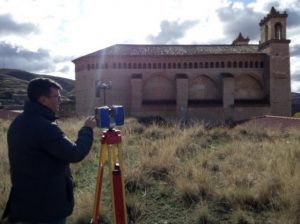
The project Arquitectura tradicional vernácula, la técnica tradicional de construcción como oficio de futuro en el ámbito rural explains that monumental Mudejar architecture shares materials and techniques with the vernacular architecture of the villages. However, throughout the 20th century, industrial development has led to a strong process of transformation and destruction of vernacular buildings and the progressive abandonment of traditional construction systems. Faced with this situation, the importance of knowledge and appreciation of local traditional architecture and its materials has been raised in order to guarantee its protection by means of an inventory and general diagnosis of materials, techniques, architecture and current use.
This research project proposes that the understanding of local traditional architecture by users avoids its replacement by new buildings and favours the development of activities aimed at its conservation. Furthermore, the projection of this architecture outside the municipality reinforces its appreciation by the local population and favours the economic revitalisation of the villages, allowing them to offer cultural experiences of longer duration than a simple visit to their most outstanding monuments.
The work aims to contribute to the valuation of traditional architecture in the area of influence of Aragonese Mudejar art, promoting the perception of indigenous construction techniques as solvent and sustainable systems, and of the buildings constructed with them as a valuable cultural heritage that must be preserved and protected; to disseminate and enhance the work of the construction craftsmen present in the area, in order to facilitate the survival of the trades and encourage the use of traditional construction techniques in interventions on vernacular heritage; and to promote the conservation, restoration and compatible rehabilitation of the traditional architecture of the area and encourage the development of sustainable and culturally respectful tourism.
To this end, we have worked to identify and study the main construction techniques present in the traditional architecture of the Mudejar villages in the south of Zaragoza, to locate the construction craftsmen present in the area and document their work, to identify and study the dynamics of intervention in traditional architecture caused by tourism, and to draw up guidelines for the compatible intervention of traditional architecture in the area of influence of the Aragonese Mudejar.
The research has been carried out in Aniñón, Ateca, Belmonte de Gracián, Cervera de la Cañada, Cosuenda, Daroca, Longares, Maluenda, Romanos, Saviñán, Terrer, Tobed, Torralba de Ribota and Villafeliche.
LÍNEA DE INVESTIGACIÓN: (1) Nuevas Miradas sobre el arte Mudéjar.
THE AUTHOR: Javier Gómez Patrocinio is an architect with a Master’s degree in Architectural Heritage Conservation and a PhD in Building, Urban Planning and Landscape Architecture from the Polytechnic University of Valencia.



